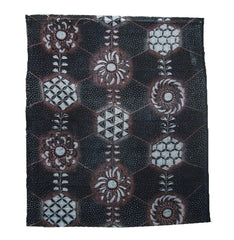An Intricately Designed and Excecuted Katazome Fragment: Beautifully Unusual
late nineteenth century
16" x 13 1/4", 40.5 cm x 33.5 cm
Sometimes in the nineteenth century katazome or stencil resist dyed cloth was designed with such invention and daring that there appeared almost-strange patterns like this one.
It is loosely arranged around the base concept of a hexagon (a reference to tortoise shell which is a symbol for long life) and shows six different motifs embedded into the network of radiating lines and points which create the background.
We see three different and highly stylized flowers along with three hexagons each of which contains another motif: on left we see shippo tsunagi or interlocking circles; in the middle we see triangles that can also be the fish scale motif; on the right we see what might be a variant on shippo tsunagi.
The color tones are a very pale--almost glowing--blue, a reddish tone based on iron oxide dye and a deep indigo.
The pattern is almost other-worldly both for its unusual design but also for the use of the few colors assigned to the parts of the pattern.


